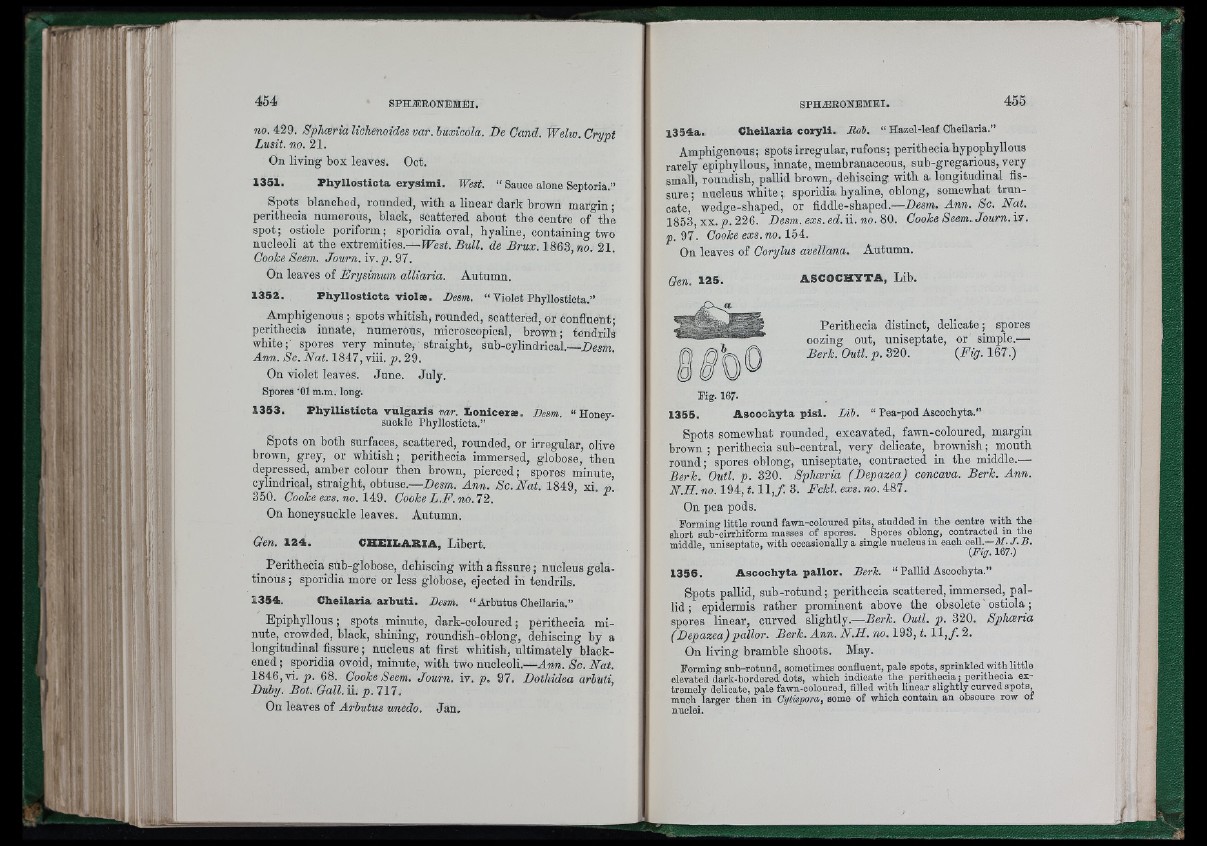
fi
il-'
no. 429. Sphærîa Uchenoides var. huxicola. De Cand. Welw. Crmt
Lusit. no. 21.
On living box leaves. Oct.
1 3 5 1 . P h y llo s t ic ta e iy s im i. West. “ Sauce alone Septoria.”
Spots blanched, rounded, with a linear dark brown margin ;
perithecia numerous, black, scattered about the centre of the
spot; ostiole poriform; sporidia oval, hyaline, containing two
nucleoli at tbe extremities.— West. Bull, de Brux. 1863, wo. 21.
Coohe Seem. Journ. XY.p. 97.
On leaves of Erysimum alliaria. Autumn.
1 3 5 2 . P h y llo s t ic ta v io læ . Besm. “ Violet Phyllosticta.”
Amphigenous; spots wbitisb, rounded, scattered, or confluent;
perithecia innate, numerous, microscopical, brown; tendrils
white; spores very minute, straight, sub-cylindrical.—Desm.
Ann. Sc. N at. 1847, viii. p. 29.
On violet leaves. June. July.
Spores '01 m.m. long.
1 3 5 3 . P h y llis t ic t a v u lg a r is m r. I io n ic e iæ . Besm. “ Honeysuckle
Phyllosticta.”
Spots on both surfaces, scattered, rounded, or irregular, olive
brown, grey, or whitish; perithecia immersed, globose, then
depressed, amber colour tben brown, pierced ; spores minute,
cylindrical, straight, obtuse.—Desm. Ann. Sc. Nat. 1849, xi. p[
350. Cooke exs. no. 149. Coohe L .F . no. 72.
On honeysuckle leaves. Autumn.
Gen. 1 2 4 . CH E ILA R IA , Libert.
Perithecia sub-globose, debiscing with a fissure; nucleus gelatinous
; sporidia more or less globose, ejected in tendrils.
1 3 5 4 . Ch eila ria a zb u ti. Besm. “ Arbutus Cheilaria.”
Epipbyllous ; spots minute, dark-coloured ; perithecia minute,
crowded, black, shining, roundish-oblong, dehiscing by a
longitudinal fissure ; nucleus at first whitish, ultimately blackened
; sporidia ovoid, minute, with two nucleoli.—Ann. Sc. Nat.
1846, vi. p . 68. Cooke Seem. Journ. iv. ». 97. Dothidea arhuti,
Duby. Bot. Gall.n. p . m .
On leaves of Arbutus unedo. Jan.
l3 5 4 a . C h eila ria c o r y li. Bob. “ Hazel-leaf Cheilaria.”
Amphigenous; spots irregular, rufous; perithecia hypopbyllous
rarely epipbyllous, innate, membranaceous, sub-gregarious, very
small, roundish, pallid brown, dehiscing with a longitudinal fissure
; nucleus wbite ; sporidia byaline, oblong, somewbat truncate,
wedge-shaped, or fiddle-sbaped.—Desm. Ann. Sc. Nat.
1853, X X . ) » . 226. Desm. exs. ed.ii. no.80. Cooke Seem. Journ. Is.
p. 97. Cooke exs. no. 154.
On leaves of Corylus avellana. Autumn.
Oen. 1 2 5 . ASCOCHYTA, Lib.
Perithecia distinct, delicate ; spores
oozing out, nniseptate, or simple.—
Berh.Outl. p . 320. {Fig. 167.)
Fig. 167.
13 5 5 . A s c o ch y ta p is i. Lib . “ Pea-pod Ascochyta.”
Spots somewbat rounded, excavated, fawn-coloured, margin
brown ; perithecia sub-central, very delicate, brownish ; mouth
round ; spores oblong, nniseptate, contracted in tbe middle.—
Berk. Outl. p . 320. Sphceria (Depazea) concava. Berk. Ann.
N.H. no. 19 4 ,1.11, f . 3. Fckl. exs. no. 487.
On pea pods.
Forming little round fawn-oolonred pits, studded in the centre with the
short sub-cirrhiform masses of spores. Spores ohlong, contracted in the
middle, nniseptate, with occasionally a single nucleus iu each cell.—Ai.XB.
(Fig. 167.)
1 3 5 6 . A s c o ch y ta p a llo r . Berk. “ Pallid Ascochyta.”
Spots pallid, sub-rotund ; perithecia scattered, immersed, pallid
; epidermis rather prominent above tbe ol»solete ostiola ;
spores linear, curved slightly.—Berk. Outl. p. 320. Sphoeria
(Depazea) pallor. Berk. Ann. N .H . no. 193, t. 11, f . 2.
On living bramble shoots. May.
Forming sub-rotnnd, sometimes confluent, pale spots, sprinkled with little
elevated dark-bordered dots, which indicate the peritheoia ; peritheoia extremely
delicate, pale fawn-coloured, filled with linear slightly curved spots,
much larger then in Gytispora, somQ of which contain an obscure row of
nuclei.